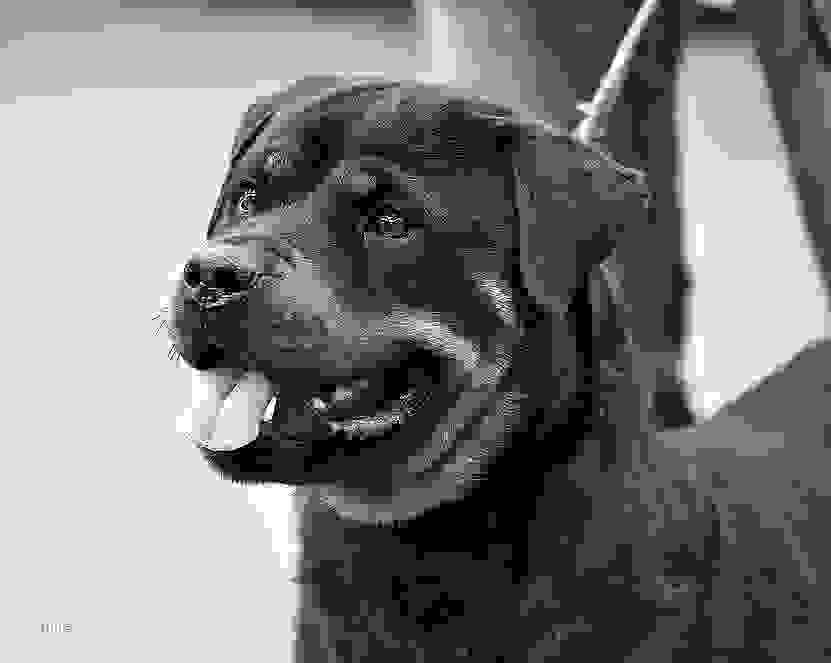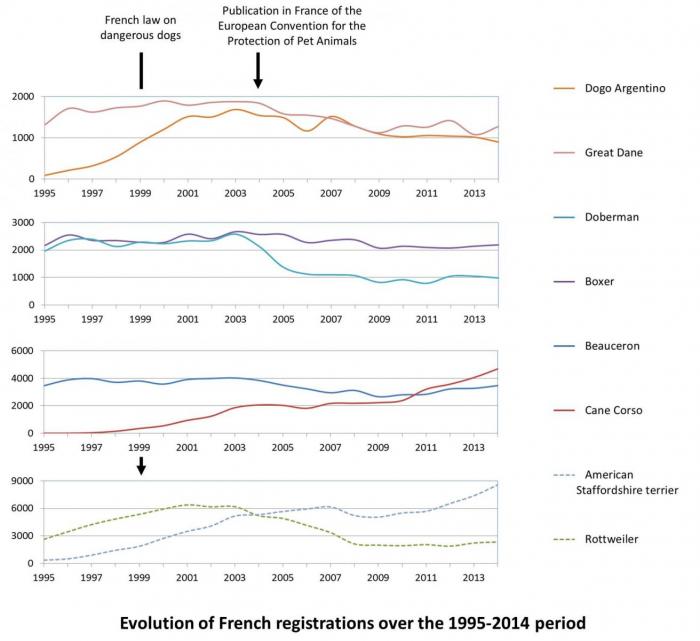How legislation impact dog breeds?
In a previous post, we investigated how a breed population can be affected by fashion effects, showing that the evolution of the popularity of a given breed is the combination of various factors. Legislation is clearly one of those factors. In this post, we will illustrate how some French dog breeds have been affected by two specific regulations, namely the France’s dangerous dogs legislation, and, in relation to ear cropping, the European Convention for the Protection of Pet Animals.
After a serie of tragic incidents that was particularly mediatized, a law was passed in 1999 in France in order to restrict the attacks on humans. Similarly to equivalent legislation in other countries, such as UK, this law targets dog breeds or breed types considered as dangerous, with two different categories. The first category includes dogs with phenotypic appearance of American Staffordshire terrier (pitbulls type), Mastiff (boerbulls type), and Tosa, not registered as purebred. Those dogs are banned from public areas, they have to be neutered and cannot be sell or given. The second category includes purebred American Staffordshire terrier, Rottweiler, and Tosa. Those dogs must be kept on leashes and muzzled in public areas. Possession of dogs of the two categories must be declared and is restricted. Those different constrains are binding for owners, and may undoubtedly have an effect on dog popularity.
European Convention for the Protection of Pet Animals (1987) states that surgical operations for the purpose of modifying the appearance of a pet animal or for other non-curative purposes shall be prohibited, in particular for the docking of tails and the cropping of ears. As a consequence, French government published the convention in 2004 for national implementation. Several measures have been then passed to ban ear cropping. Note that tail docking remains however unrestricted in France, considering potential tail injury that may experience hunting dogs moving through dense vegetation. Several breeds have been concerned by the legislation on ear cropping, including Boxer, Doberman, Great Danes, American Staffordshire terrier, Cane Corso, Beauceron, or Dogo Argentino. The potential impact on breed population is related to change in appearance of the breeds, which may prevent owner used to dogs with cropped ear.
We may suppose that popularity of the breeds targeted by those legislations has been affected (especially for American Staffordshire terrier, concerned by both), but is it so simple? In the following graph, we consider the evolution of French registrations over the 1995-2014 period for targeted breeds (results were restricted to breeds with more the 1000 annual registrations over the last years).
On the one hand, for six breeds out of eight, national registrations have experienced sharp decreases, ranging between 10 and 60% over the 10 years following implementation of the decision (in 1999 for Rottweiler and in 2004 for the other breeds). In most cases, registrations stabilized after a few years.
On the other hand, growing popularity of American Staffordshire terrier and Cane Corso breeds did not seem to be much impacted by those legislations. Eventually a stabilization of registrations could be observed after the publication of the European Convention for the Protection of Pet Animals, while considering dangerous dogs legislation, it could be hypothesized that the law had actually a positive effect on the popularity of purebred American Staffordshire terrier. Indeed as non-pure bred American Staffordshire terrier were classified in the first category, it is probable that a large proportion of owners decided to get purebred ones instead, as the constraints related to the second category were much less binding. In the case of Cane Corso, it is interesting to relate the lack of effect of the ban on ear cropping to the fact that the breed was unknown in France until the end of the 90s. On contrary to more traditional breeds, French owners were not used to cropped ears, which may explain that the change was not perceived by most of owners. Effect on the dog esthetic and how it has been perceived by public may also have differed according to breeds own phenotypes.
These examples illustrate quite well how breed demography is affected more or less directly by national and international legislation. In the next years, we may expect that future legislations, in particular those related to health and welfare, will impact as well dog breeds, leading to the eventual ban of some of them, as it has proposed over the last years by Nordic countries for some cattle breeds. This is one reason why it is important for breeders and kennel clubs to work on the health of their breeds, before national and international legislation take drastic decision for them.
Credit picture: I. Horvath
 Donate
Donate



0 Comments
Recommended Comments
There are no comments to display.